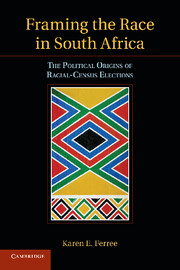Book contents
- Frontmatter
- Contents
- List of Tables
- Acknowledgments
- 1 Introduction
- 2 Voters
- 3 The 1994 Campaigns
- 4 The 1999 Campaigns
- 5 The 2004 Campaigns
- 6 Can a Leopard Change Its Spots? Candidate Demographics and Party Label Change
- 7 Why So Slow? The Political Challenges of Candidate Transformation for Opposition Parties
- 8 Negative Framing Strategies and African Opposition Parties
- 9 Conclusion: South Africa in Comparative Perspective
- References
- Index
- Titles in the series
9 - Conclusion: South Africa in Comparative Perspective
Published online by Cambridge University Press: 06 December 2010
- Frontmatter
- Contents
- List of Tables
- Acknowledgments
- 1 Introduction
- 2 Voters
- 3 The 1994 Campaigns
- 4 The 1999 Campaigns
- 5 The 2004 Campaigns
- 6 Can a Leopard Change Its Spots? Candidate Demographics and Party Label Change
- 7 Why So Slow? The Political Challenges of Candidate Transformation for Opposition Parties
- 8 Negative Framing Strategies and African Opposition Parties
- 9 Conclusion: South Africa in Comparative Perspective
- References
- Index
- Titles in the series
Summary
While the beginnings of South Africa's racial census lie in its past, in the effects apartheid had on voters' beliefs about race and destiny and the reputations parties forged during this period, the enduring imprint of race on elections reflects current politics, in particular the ruling party's ability to use the powers and benefits of office to frame elections and prevent opposition parties from transforming the uncompetitive party images they inherited from apartheid into ones that would give them broader appeal in the electorate. By keeping these parties “white,” by preventing them from evolving in a more multi-racial direction, the ANC has rendered them toothless.
In this final chapter, I consider two additional cases: El Salvador and Israel. I show that dominant parties in both countries used image control and negative framing strategies to discredit their opponents and fortify their own hold on power. The power of the frame, the ability to shape how the electorate views the opposition, is thus a general tool that dominant parties use to continue their rule. While much current research has focused on resource-based strategies for control (especially clientelism), the case material from El Salvador, Israel, and South Africa all point to the importance of broadening our understanding of the repertoires of dominance. Dominant parties most certainly depend on their monopoly over resources to maintain power. At the same time, they cannot buy off all of the voters all of the time.
- Type
- Chapter
- Information
- Framing the Race in South AfricaThe Political Origins of Racial Census Elections, pp. 222 - 242Publisher: Cambridge University PressPrint publication year: 2010

